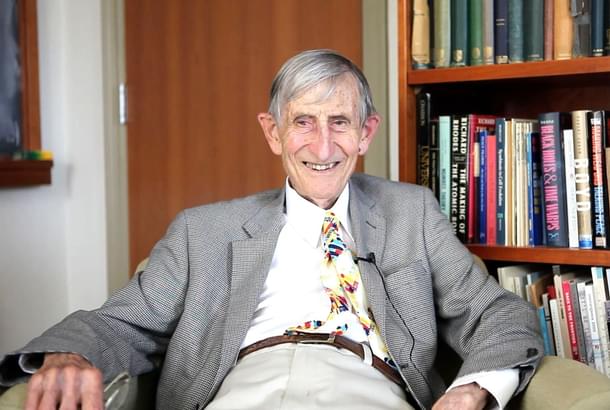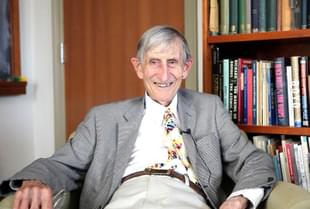Science
Obit: Freeman Dyson, The Genius Physicist Who Helped Bring Japan’s ‘Sacred’ Math To The World, Dies At 96
Aravindan Neelakandan
Feb 29, 2020, 04:02 PM | Updated 04:02 PM IST
Save & read from anywhere!
Bookmark stories for easy access on any device or the Swarajya app.


Fukagawa Hidetoshi has spent most of his life, almost four decades, as a high school teacher in Japan. And he had a passion — passion for sangaku, wooden tablets with mathematical designs hung in Shinto (and also some Buddhist) shrines in Japan.
They contain an implicit challenge to anyone interested in geometry — proving the informal geometrical theorem contained in them. But the wooden tablets perish. Customs die. Fukgawa Hidetoshi found out that they needed to be preserved for posterity and presented to the world.
He collected them enough to fill a book. But the rigid academic system in Japan would not consider the work worthy of notice. Undaunted, he sent his work to six world famous mathematicians interested in geometry.
Of them, only one responded and he was quite interested. British Mathematician Daniel Pedoe, who had moved to the US, when he saw the work, got enchanted with sangaku.
Thus, started a collaboration which brought the wonder of the temple wooden tablets to the world.
Pedoe had a brilliant student, also a famous physicist who had also emigrated to the US. Pedoe showed sangaku to the physicist who was his student almost four decades ago.
In 1993, the famous physicist who was the boy-student of Pedoe, visited Japan. There, he had made arrangements to meet Fukagawa. But his hosts were not much encouraging. The physicist explains:
My academic hosts expressed surprise that I should wish to speak with a “lowly” high- school teacher, and tried to cut my visit with him short. They allowed me only a few hours to spend with him, visiting a temple where some outstanding sangaku are preserved and an abacus museum where we could see other artifacts of indigenous Japanese mathematics. I would happily have stayed longer, but my hosts were inflexible. Since then, I have stayed in touch with Fukagawa as he continued to make new discoveries and deepen his understanding of the historical context out of which the sangaku emerged.
That physicist was Freeman Dyson (1923-2020).
Freeman realised the importance of the work and arranged for another scholar to cooperate with Fukagawa, Tony Rothman. Thus, came the book Sacred Mathematics: Japanese Temple Geometry published by Princeton University Press. The physicist himself wrote an insightful preface.
Dyson had made foundational contribution to quantum electrodynamics (QED) as a graduate student. And he had interest in every domain of scientific knowledge — from QED to the origin of life question to the extra-terrestrials.
He was also interested in social issues. He considered himself a non-denominational Christian but an agnostic with respect to specific aspects of faith.
He had reverence for Gandhi and Tolstoy. Such a dynamically curious mind operating over a period of more than six decades created its own spaces for disagreement with some on some issues — like his insistence that global warming could not only create devastating effects but also could have some beneficial effects which too should be studied.
His acceptance of the Templeton award was seen as a let-down by Richard Dawkins.
In 1978, Dyson was attacked by muggers and left in the ground with a fractures and bleeding. Dyson explained the feeling then as he was getting himself ready to be shot by his attackers, a decade later:
Two friendly bandits have fractured my skull and jaw and relieved me of my wallet. I am expecting that one of them may shortly put a bullet into me to make sure I will not talk. And now, at this unlikely moment, my spirit is filled with peace. The green leaves and the blue sky are beautiful. Everything else fades into insignificance. This life is good and this death is good also. I am a leaf like the others. I am ready to float away on the blue wave of eternity.
In the same article, he also wrote about the need to be in tune with our natural value system and then he also wrote about the then emerging and hotly contested ‘Gaia hypothesis’. Gaia hypothesis put forth by Lynn Margulis and James Lovelock proposed that the entire planet acts as a kind of self-regulating system, and life planning a dynamic role in regulating planetary temperature and matter-energy cycles. The whole article is worthy of meditation not by science enthusiasts but by humanity at large:
The central complexity of human nature lies in our emotions, not in our intelligence. Intellectual skills are means to an end. Emotions determine what our ends shall be. Intelligence belongs to individual human beings. Emotions belong to the group, to the family, to the tribe, to the species, or to Nature. … Emotions must be our pulley. Somehow or other, when we begin to improve artificially the physical and intellectual capacities of our children, we must learn to leave their emotional roots uncut. Any change in our natural value system carries the danger of running into such a vicious cycle. Any short circuit of the value system is a form of insanity. To be sane means to possess a value system that allows us to survive on all time scales in harmony with Nature. One hopeful sign of sanity in modern society is the popularity of the idea of Gaia, invented by James Lovelock to personify our living planet. Respect for Gaia is the beginning of wisdom.The Face of Gaia (1989)
After a fall in the cafeteria of the Institute of Advanced Studies in Princeton University, Freeman Dyson died three days later on 28 February 2020. The Institute of Advanced Studies in Princeton was his ’academic home’ for more than six decades. The feeling scientist has moved into the ‘blue wave of eternity’. ॐ शान्तिः
Aravindan is a contributing editor at Swarajya.





